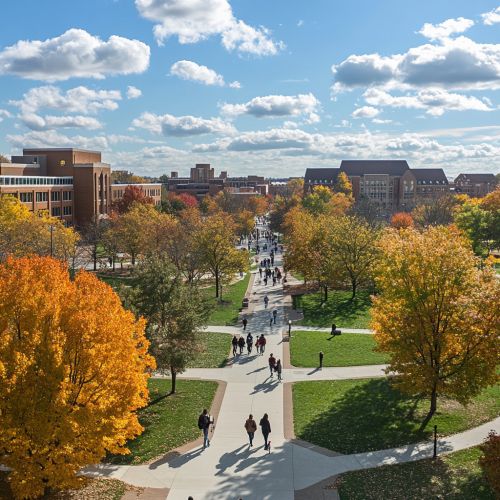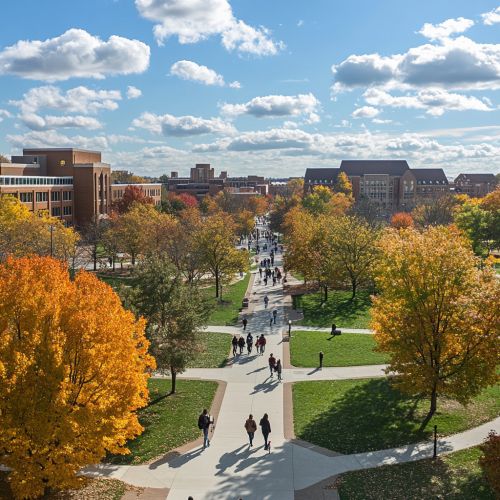West Lafayette, Indiana
History
West Lafayette, Indiana, is a city located in Tippecanoe County, across the Wabash River from its sister city, Lafayette. The area that would become West Lafayette was originally inhabited by Native American tribes, including the Miami and Potawatomi. European settlers arrived in the early 19th century, and the city was officially incorporated in 1888.
The establishment of Purdue University in 1869 significantly influenced the development of West Lafayette. John Purdue, a prominent businessman, donated land and funds to establish the university, which has since become a major research institution. The presence of Purdue University has shaped the city's economy, culture, and demographics.
Geography
West Lafayette is situated in the northwestern part of Indiana, approximately 65 miles northwest of Indianapolis. The city covers an area of 7.63 square miles, with the Wabash River forming its southern boundary. The terrain is characterized by gently rolling hills and fertile soil, typical of the Midwest.
The climate in West Lafayette is classified as humid continental, with four distinct seasons. Summers are warm and humid, while winters are cold with moderate snowfall. The average annual precipitation is around 40 inches, contributing to the region's agricultural productivity.
Demographics
As of the 2020 census, West Lafayette had a population of approximately 44,595 residents. The city has a diverse population, largely influenced by the presence of Purdue University. The student population contributes to a youthful demographic, with a median age of around 22 years.
The racial composition of West Lafayette is predominantly White, with significant Asian, African American, and Hispanic communities. The city's educational attainment levels are high, with a large proportion of residents holding advanced degrees, reflecting the influence of the university.
Economy
The economy of West Lafayette is closely tied to Purdue University, which is the largest employer in the area. The university's research and development activities have spurred the growth of technology and innovation sectors. The Purdue Research Park, established in 1961, is a hub for high-tech companies and startups, fostering economic growth and job creation.
Agriculture also plays a role in the local economy, with the surrounding region producing corn, soybeans, and other crops. Additionally, the city has a growing service sector, including retail, healthcare, and education services.
Education
Purdue University is the cornerstone of West Lafayette's educational landscape. The university is renowned for its programs in engineering, agriculture, and the sciences. It is a member of the Big Ten Conference and has a strong emphasis on research and innovation.
The West Lafayette Community School Corporation operates several public schools, including West Lafayette Junior-Senior High School, which consistently ranks among the top high schools in Indiana. The city's commitment to education is evident in its well-funded and high-performing school system.
Culture and Recreation
West Lafayette offers a vibrant cultural scene, with numerous events and activities centered around Purdue University. The university's Elliott Hall of Music hosts concerts, theatrical performances, and lectures. The Purdue Convocations program brings a variety of cultural and artistic events to the community.
The city boasts several parks and recreational facilities, including the Celery Bog Nature Area, a wetland preserve with trails and wildlife viewing opportunities. The Wabash Heritage Trail provides scenic views along the river, making it a popular spot for hiking and biking.
Transportation
West Lafayette is well-connected by a network of roads and highways, including Interstate 65, which provides easy access to Indianapolis and Chicago. The Greater Lafayette Public Transportation Corporation (CityBus) operates a comprehensive bus system, serving both West Lafayette and Lafayette.
The city is also served by the Purdue University Airport, which offers general aviation services and limited commercial flights. Amtrak provides rail service through the nearby Lafayette station, connecting the area to major cities in the region.
Government
West Lafayette operates under a mayor-council form of government. The mayor is elected to a four-year term and is responsible for the executive functions of the city. The city council, composed of nine members, serves as the legislative body, enacting ordinances and approving budgets.
The city government focuses on maintaining infrastructure, providing public safety services, and promoting economic development. West Lafayette is known for its proactive approach to sustainability, with initiatives aimed at reducing carbon emissions and promoting green practices.
Notable Landmarks
West Lafayette is home to several notable landmarks, many of which are associated with Purdue University. The Purdue Mall, often referred to as the "Engineering Mall," features the iconic Engineering Fountain and the Neil Armstrong Hall of Engineering. The Bell Tower, a prominent campus landmark, serves as a symbol of the university.
The Samara House, designed by renowned architect Frank Lloyd Wright, is another significant landmark. This Usonian-style home is a testament to Wright's architectural philosophy and is open to the public for tours.
See Also


